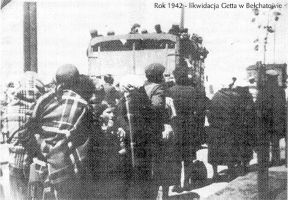![]()
Belchatow's Jews
 | (From Bulletin No. 2 of the Association of Friends of Belchatow, June 2001) (Click on photo of Bulletin for larger view.) |
Translated from the Polish by Dana Rothschild
Also here, as in Jerusalem, |
|
Fifty-nine years ago, in August 1942, there took place the last act of the drama of the Jewish population of Belchatow, which was occupied by the German Nazis [Hitlerists, as they are called in Polish].
*
During more than 700 years Jews were living and working among the Poles; Poland and Belchatow was their homeland.
The years of WWII provide a clear censorship in the history of Belchatow. Up to this time Belchatow, an accounted textile center in district of Lodz, was a multinational town.
In 1939, shortly before the outbreak of WWII, Belchatow counted 12,000 residents: 5,000 Poles, 1,000 Germans, and 6,000 Jews. In 1945 the population of Belchatow was counted at 3,500 people.
Although documents about the Jewish population in Belchatow reach back to the 18th Century, we can speak about the influence of this important national group on the town’s development only from 19th Century. Through favorable circumstances, Belchatow was developing as a city with a lot of chances for venturesome Jews.
During this time a lot of brick houses were built. Next to the developing factories of Mendel Tuska, Lejzor Warszawski, Jankiel Guderman and others, one-storied tenement houses were built, which gave the central streets a town character.
In 1893 the Jewish Community, with the considerable financial help of Jewish factory-owners, build a new Synagogue. This building was erected on the crossing of today’s Fabryczna Street and 19 January Street (former Evangelic Street). At the same time the Community also bought the grounds for the new cemetery on the present Lipowa Street. (The old Jewish Cemetery was located on the west side of Kempfinowka Street).
In the twenty years between the wars, Jewish society took part in the economical and cultural life of the city.
*
During the Nazi occupation, the Jewish community of Belchatow suffered irreversible losses. When they entered Belchatow, the Germans closed the synagogue. Systematically they destroyed everything that was connected to Jewish religion and culture.
On the present Freedom Square they burned valuable libraries. The Jewish population were deported from their homes and crammed into the ghetto in the region of Fabryczna, Pabianicka, Sienkiewicz and Pilsudski Streets. The Ghetto of Belchatow, even if not surrounded by a wall as in the big cities, was a place where, in a small area, several thousand Jews lived in terrible conditions. An additional element, which worsened their existence, was the forced settlement of Jews from nearby localities. In this small strip of Belchatow, isolated by the Germans, Jews from Szczercow, Widawy, Zelowa and Lask were “settled,” bringing with them only hand luggage. This brought a terrible housing shortage in the already over-populated apartments. Every resident of the Ghetto was obliged to wear a white armband, not narrower then 10cm, with a blue so-called “Star of David."
The Jews could leave this isolated area for work in town. From nightfall they all had to be in their homes. It was forbidden at this time to look out the windows. There were cases of Germans shooting at the people who were looking through the windows.
From the very first days of occupation, the Germans treated the Jews with inhuman contempt, which brought out barbarian and often degenerated “games.”
The Jewish Council was obliged to transfer to the Third Reich more and more money.
On the 18th of March 1942 a group execution of 10 Jewish hostages took place on the west side of Kosciuszki Street.
The real tragedy occured in 1942.
At the Wannsee conference in January 1942, Heydrich was informed about the ready plan for the “final solution to the Jewish question,” as the intention to murder all Jews of Europe in special extermination centers using gas chambers was euphemistically described, located on the terrain of General Guberniya. It was the last stage of extermination, also for the Jews from Belchatow. In August 1942 almost everybody was unexpectedly transferred to the Lodz Ghetto, to the camp of Chelmno on the river Ner, and to other places of extermination. Whole Jewish families were put on the trucks, which were waiting on the square near Targowa Street (so called Targowica).
The majority of the Jewish people were not aware that this was their last journey. Only a few tried to escape, and only some of them were successful.
So it happened to one of the Jewish families, who were hiding for several days near Targowica. When the action of pacification ended, this family tried on their own to cross the border near Bogdanow and arrived at Piotrkow, where their friends lived. This attempt was successful.
The Germans destroyed the Jewish cemetery at Lipowa Street. The grave plates, so called “matzevas,” were used for hardening roads and bridges. The synagogue was plundered and, like the church of N.M.P. (Saint Mary), transferred into warehouses.
The Nazi human killing machine wanted also to make extinct the material aspects of Jewish culture, her most valuable and precious mementos, Holy books, liturgical utensils, cemeteries, synagogues, everything, ....... everything.
*
There are no more Jewish Shtetls in Poland
In Hrubieszow, Karczew, Brody and Palenica
You look for candlelight in the windows
And for song in the wooden synagogue in vain
Antoni Slonimski,
“Elegy for Jewish Shtetl”
But this gloomy work didn’t succeed in full. It looked like nothing in our city was left from the joint past, agreeable coexistence of Jewish and Polish population.
However…….
*
For some time there has been a growing interest for old Jewish culture. In Belchatow commemorative plaques remind us of the Jewish population: one on Narutowicz Place, opposite the former synagogue, the second on the former Jewish Cemetery, where in 1992, on the 50th Anniversary of the Liquidation of the Ghetto, a memorial obelisk was erected. In its base were placed fragments of old Jewish “matzevot.”
Lots of old photographs were preserved, as well as some books and small objects, which were the beginning of the collection of Judaica in the Belchatow Museum.
More and more often the former residents of Belchatow who survived the atrocity come to visit the town.
A moving meeting with a small group of Jews who survived took place during the 50th Anniversary of these events in August 1992. From all over the world, from Argentina, Israel, the United States, Australia and Germany, they came with their families. Menachem Sharon, now living in Tel Aviv, who as a young boy escaped from these tragic events, reminded the assembled residents of Belchatow of the atrocities of the last war. Over their heads flew the tones of “The Funeral March” of Chopin.
Near the Memorial Plaque, flowers and wreaths were placed. The Orchestra of KWB [Kopalnia Wegla Brunatnego – Mines of Brown (wood) Coal] played the Jewish song “The Partisan of Wilen,” whose words sounded in an unusual way, raised with trembling lips and tears in the eyes of the guests.
The meeting with the older residents of Belchatow, meeting with former school friends and playmates were also very moving. The phrase said by Szumel Flakowicz, one of the participants of the meeting, shows the sentiment to our town:
As Jews we always were proud of Belchatow, as place of our origin, our cradle. A lot of families, who come from here, took the very worthy name Belchatowski.
*
 | I think that, in our full-of-action day, it is worthwhile to stop for a moment to remember this historic time, because this is also our Polish history. Boguslaw Dziedzic
|
The former Synagogue in Belchatow |
![[photo of Boguslaw Dziedzic and Roni S. Liebowitz]](images/director_with_roni_2001.jpg)
Boguslaw Dziedzic conferring with Roni Seibel Liebowitz
during her trip to Belchatow in July 2001.
(Photograph courtesy of Roni Seibel Liebowitz)
